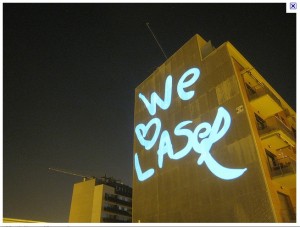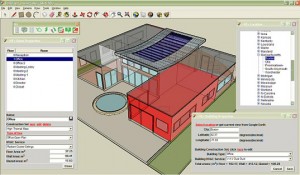Archive for category Built Environment
Laser to Revit : Laser to BIM : New Tools to Capture the Built Environment
Posted by Jim Foster in BIM, Built Environment, disto, Laser BIM, Revit on November 13, 2010
 With PointKnown’s introduction of PKNail and PPLT (Point to Point Laser Technology) utilizing a Leica Disto and Rand Technologies recent press release announcing the ability to manipulate and manage laser scan, point cloud data within Revit the opportunity and tools to capture existing conditions continues to grow. Combine that with the growing need to capture existing conditions for energy modeling and retrofits and you can see an industry emerging, not just using it for special circumstances but start capturing existing structures in 3D/BIM for uses that range from space planning, facility management, energy audits and beyond.
With PointKnown’s introduction of PKNail and PPLT (Point to Point Laser Technology) utilizing a Leica Disto and Rand Technologies recent press release announcing the ability to manipulate and manage laser scan, point cloud data within Revit the opportunity and tools to capture existing conditions continues to grow. Combine that with the growing need to capture existing conditions for energy modeling and retrofits and you can see an industry emerging, not just using it for special circumstances but start capturing existing structures in 3D/BIM for uses that range from space planning, facility management, energy audits and beyond.
While it has been reported and analyzed that some of the biggest frustrations, time sinks and expenditures is that lack of interoperability between software, and redundant efforts between disciplines, that is creating the same thing, many times for each discipline the advent of BIM authoring tools like Revit, and ways to combine and work with them can help firms and individuals reduce rework and create more opportunities for their design and construction work; looks like a win all around. And with these technologies firms can start on existing structures in BIM and Revit and have all the benefits.
Obama Administration Boosts Retrofits : Biden Announces Fed Program
Posted by Jim Foster in BIM, Built Environment, Sustainable Retrofits on November 12, 2010
 Am I calling it or what? As reported by Martin LaMonica on CNET and the Steven Thomma of the Miami Herald Vice President Joe Biden with US Department of Energy Secretary Steven Chu on Tuesday unveiled a new federal program to make it easier for Americans to make their homes more energy efficient, saying it will help people save money and create new jobs for contractors.
Am I calling it or what? As reported by Martin LaMonica on CNET and the Steven Thomma of the Miami Herald Vice President Joe Biden with US Department of Energy Secretary Steven Chu on Tuesday unveiled a new federal program to make it easier for Americans to make their homes more energy efficient, saying it will help people save money and create new jobs for contractors.Excerpts for the release below:
“The initiatives announced today are putting the Recovery Through Retrofit report’s recommendations into action – giving American families the tools they need to invest in home energy upgrades.” said Vice President Biden. “Together, these programs will grow the home retrofit industry and help middle class families save money and energy.”
“The Home Energy Score will help make energy efficiency easy and accessible to America’s families by providing them with straightforward and reliable information about their homes’ energy performance and specific, cost-effective energy efficiency improvements that will save them money on their monthly energy bills,” said Secretary Chu.
Under this voluntary program, trained and certified contractors will use a standardized assessment tool developed by DOE and Lawrence Berkeley National Laboratory to quickly evaluate a home and generate useful, actionable information for homeowners or prospective homebuyers. With only about 40 inputs required, the Home Energy Scoring Tool lets a contractor evaluate a home’s energy assets, like its heating and cooling systems, insulation levels and more, in generally less than an hour. That means a homeowner can see how their home’s systems score, regardless of whether a particular homeowner takes long or short showers or keeps their thermostat set high or low.
The following states and municipalities are participating in the pilot program: Charlottesville, Virginia; Allegheny County, Pennsylvania; Cape Cod and Martha’s Vineyard, Massachusetts; Minnesota; Omaha and Lincoln, Nebraska; Indiana; Portland, Oregon; South Carolina; Texas; and Eagle County, Colorado. Learn more about each of the testing locations along with details on how to participate in the Home Energy Score program.
Consumers can apply for up to $25,000 in PowerSaver loans through the U.S. Department of Housing and Urban Development, which expects that 24,000 homes will qualify during a two-year pilot program, according to USA Today.
This home energy retrofit program follows a $5 billion weatherization investment that was part of the stimulus package last year. Another effort is Home Star, nicknamed Cash for Caulkers, which would provide rebates to consumers for investing in energy efficiency retrofits.
Read more: http://news.cnet.com/8301-11128_3-20022184-54.html#ixzz155UA7FTa
How does this effect BIM users/developers, etc.?
Commercial deployment will be huge and has more robust documentation and reporting needs, plus these firms getting into it will need to have better tools, etc as the race begins to fill these needs and to differentiate themselves from competition, imagine a 3D BIM model with all the reporting built into it. I have to imagine the plug ins are already under development. Additionally, did you notice the certification needs recommended for this. Strap it on, let’s get back to work.
Buckeyes on board with BIM – Post Protocol : Ohio BIM
Posted by Jim Foster in Adoption, BIM, Built Environment on November 11, 2010
 So I think the NY Post would be impressed with that amount of alliteration. But as reported before Ohio becomes the third state to require BIM on projects. The Ohio SAO (State Architects Office) posted the protocols and available here. But here are the nuts of the requirement.
So I think the NY Post would be impressed with that amount of alliteration. But as reported before Ohio becomes the third state to require BIM on projects. The Ohio SAO (State Architects Office) posted the protocols and available here. But here are the nuts of the requirement.
- All projects (new construction, additions, and alterations) with a total project value funded through state appropriations of $4 million or greater; or
- All projects (new construction, additions, and alterations) funded through state appropriations where the total estimated value of plumbing, fire protection, HVAC, and electrical work within the project is greater than 40% of the value of construction.
Greening the Built Environment : Autodesk joins IBM’s Green Sigma Coalition : IBM Flexing its Market Power Muscle : BIM
Posted by Jim Foster in BIM, Built Environment on October 5, 2010
 Quick jumble from IBM to BIM and it seems a lot of threads are coming together between IBM and the AECOM community. Smart Buildings and Smart Cities, IBM and Dassault, IBM Maximo, etc. How this comes to grind with LEED, and EnergyStar initiatives , etc remains to be seen but there is quite a roster to this invite only list. Charter members include: Johnson Controls, Honeywell Building Solutions, ABB, Eaton, ESS, Cisco, Siemens Building Technologies Division, Schneider Electric and SAP but nothing like owning the process and selling services, hardware, software, product to achieve Green Sigma. The process itself :
Quick jumble from IBM to BIM and it seems a lot of threads are coming together between IBM and the AECOM community. Smart Buildings and Smart Cities, IBM and Dassault, IBM Maximo, etc. How this comes to grind with LEED, and EnergyStar initiatives , etc remains to be seen but there is quite a roster to this invite only list. Charter members include: Johnson Controls, Honeywell Building Solutions, ABB, Eaton, ESS, Cisco, Siemens Building Technologies Division, Schneider Electric and SAP but nothing like owning the process and selling services, hardware, software, product to achieve Green Sigma. The process itself :
“Combines real-time metering and monitoring with advanced analytics and dashboards that allow clients to make better decisions that improve efficiency, lower costs and reduce environmental impact.”
IBM goes on to outline the validation process which is, you guessed it, validated by IBM. How this differs from LEED which:
… is an internationally recognized green building certification system, providing third-party verification that a building or community was designed and built using strategies aimed at improving performance across all the metrics that matter most: energy savings, water efficiency, CO2 emissions reduction, improved indoor environmental quality, and stewardship of resources and sensitivity to their impacts.
Now I am a capitalist so increasing shareholder value is something I take to heart, sure there’s a lot more in the mix than that and who am I to take IBM to task for flexing its market power muscle but aren’t we talking the same side of the coin only IBM wants to own the coin too. One could argue that Green Sigma is the practical application of LEED principles. That should keep respective communication departments off my back. Regardless of who owns the process the end goal for each is laudable, and now proven that ‘green’ is good business.
As reported by Lauren Browne at Connect Press IBM brought Autodesk in for its expertise in modeling and the built environment.
“It occurred to IBM, that it would make sense, given that the built environment requires multiple layers of solution sets including hardware, software, services, financing, etc. that no one company could do this (tackle greening the built environment) in isolation. And if they did, they would be handicapping themselves.” – Emma Stewart, Senior Program Lead, Sustainability, Autodesk.
This could help explain the Photofly and PointCloud tools expected in the most recent release of Autocad but if you start doing the math, +$400 billion in sustainable retrofits, +75% of construction done in the built environment you understand why the big guns are out.
More firms entering the PointCloud from Photo Biz: Areoscan to launch shortly
Posted by Jim Foster in 3D, Built Environment, New Technologies on September 7, 2010
While Autodesk labs has already made Photofly available for free over the web another competitor has thrown their hat into the PointCloud from Photos ring, Areoscan , and I have to say they are playing a game of catch up with Autodesk, who I believe already has a pretty good reseller network and did I mention Photofly is currently free. Add to this battle that Autodesk most will likely have the functionality built into the next AutoCAD release and its a big hill they are starting to climb. So I can’t say if there will anything new or compelling in order to pay for the service, unless they are going to fly you to their HQ in New Zealand for a personal demo. And don’t get me wrong I am always rooting for new companies but right now cannot see how the services between Photofly and Areoscan differ, except Photofly is free and Areoscan is more difficult to pronounce.
Sustainable Retrofits Projected to be $400b US Market by 2030
Posted by Jim Foster in Built Environment, Green, New Technologies, Sustainable Retrofits on August 27, 2010
 I had a conversation yesterday with as Program Manager from Autodesk who was looking into implementing workflows utilizing Autodesk Products to produce energy analysis for existing buildings. He had seen one of our many fantastic videos for PKNail, okay we have two homegrown videos, but our effort in capturing the built environment dovetails nicely with this effort. And while I have commented many times on the sustainable retrofit market I had not seen a number placed on it but Autodesk posted a number on their web site. If you are not intending to make the jump you can read some of their conclusions below.
I had a conversation yesterday with as Program Manager from Autodesk who was looking into implementing workflows utilizing Autodesk Products to produce energy analysis for existing buildings. He had seen one of our many fantastic videos for PKNail, okay we have two homegrown videos, but our effort in capturing the built environment dovetails nicely with this effort. And while I have commented many times on the sustainable retrofit market I had not seen a number placed on it but Autodesk posted a number on their web site. If you are not intending to make the jump you can read some of their conclusions below.
Buildings are key to achieving climate stabilization, representing roughly 40% of global energy consumption and 25% of global carbon emissions. In addition, energy efficiency retrofits represent a massive latent market, projected to reach an estimated worth of $400 billion by 2030 in the U.S. alone. To respond to these twin environmental and market demands at scale and speed, the building industry needs to respond quickly and cost-effectively.
Our research suggests that rapid energy modeling enables building energy assessments with a smaller budget and shorter time frame, and can thereby help increase the number of existing buildings that undergo assessment and energy upgrades. We expect property owners and managers, home buyers, tenants and landlords, designers and architects, auditors, and energy consultants to benefit from such a workflow.
Included in this effort is Revit CEA (Conceptual Energy Analysis) that allows the user, after putting parameters in place, to use a cloud computing enironment, that is send it out for computation, to perform the calculations using Green Building Studio as the back end but making it transparent to the user. What I like about this effort is that I am not required to fire up or even know Green Building Studio to do the energy analysis, the export and data exchange, done in gbXML is done seemlessly and I get the report.
But back to the original premise which is getting existing buildings into a format that you can perform this and Autodesk has developed a workflow to help, and while this is excellent I would also argue for PKNail’s place in the workflow as measuring and building in the environment you are going to model and analyze reduces a couple of steps and amount of software you need to know. I don’t argue it should be the only tool just that it deserves a place on the shelf.
We’re Going Inside : Buildings and BIM
Posted by Jim Foster in 3D, Built Environment, New Technologies on August 20, 2010
New technologies have developed around the capture capture of existing buildings in a digital environment. Laser Scanning comes first to mind, and now Photofly from Autodesk, however, these seem to best address the exterior of the buildings and are used in particular circumstances that warrant them. Now comes the backpack scanner, and thanks to Erik Lewis and his blog Who’s Afraid of the Big Bad BIM for bringing it to my attention and I’ll quote him here:
“Incredible. Between PKNail and emergent technology like this, I see a real future in gathering existing facilities information into BIM databases…”
Laser Backpack Creates Instant 3D Models
Very cool.
Autodesk taking as builts seriously : Photo Modeling and PointClouds in next release?
Posted by Jim Foster in Autodesk, Built Environment, New Technologies on August 16, 2010
With all the stuff flying out of Autodesk Labs recently one maybe blinded by the technology slant rather than the strategy. Looking specifically at Photofly and their new PointCloud tools with shape extraction Autodesk is putting together a strong effort in capturing the built environment within their CAD platform. Looking at the ribbon from an AutoCAD beta you can see that Photo Modeling and PointCloud are options available directly within the menu.
You can see these option on the far right, somewhat obscured by one of my feeds. Yes, my blog formatting skills still need fine tuning. Last time we researched this over 80% of construction in Boston was done within existing buildings. This new technology push with our own research dove tails nicely with the sustainable retrofit anecdotes.
I think it becomes more important that applications work within familiar platforms to not not only increase their adoption but also to incorporate into an existing workflow. Asking anyone to learn a new platform is always a tougher hill to climb and most shops are standardizing their drafting/modeling on to one or two applications.
From a technology stand point, the more tools the more better because this has been a soft spot in the whole CAD/BIM world, that is I am working in an existing building, I use Revit, I used AutoCAD, okay, now where do I start. Defining this will help everyone.
Rapid Energy Modeling : Sustainable Retrofits : The Market, Tools & Techniques : BIM
Posted by Jim Foster in BIM, Built Environment, Green, Laser BIM, Point to Point Laser Technology on May 19, 2010
There is a virtuous circle afoot and it’s not just how you spin social networking to acquire traffic it is sustainable retrofits and if you wonder what’s the next big thing, what gets us out of this economic tailspin, or at least malaise too many data points are starting to point in the sustainable retrofit direction. ARRA (American Relief and Recovery Act) money points that way, the President speaks about green jobs, Autodesk is hyping it and I am being constantly contacted from firms wanting to use our technology, PointKnown , to augment their green building practices. And the best thing about it, it makes sense, unlike pets.com which use to ship dogfood to you via fedex.
Here are some stats, most of them gleaned from an Autodesk Paper, (from the I read it so you don’t have to category).
-
Approximately 75 percent of buildings globally will be either new or have undergone significant renovation by 2035 (1)
-
About 150 billion square feet of existing buildings (roughly half of the entire building stock in the United States) will need to be renovated over the next 30 years. (2)
-
A recent analysis estimates that green building retrofits in the United States represent a $400B market in the next 20 years. (3)
(1) http://www.architecture2030.org/ (2009)
(2) American Institute of Architects (AIA) COTE (2009), Ecology and Design: Ecological Literacy in Architecture Education.
(3) Pike Research (2009), “Energy Efficiency Retrofits for Commercial and Public Buildings,” Executive Summary.
That means work up and down the line from surveying and modeling buildings, through energy analysis, the design process through constrcution. But the reason it makes most sense is that there is viable and real ROI not just from the environmental benefit but also from the energy savings. Autodesk’s argument, while self-serving, provides some valid points.
• Supplement energy benchmarking by providing numerous design alternatives to users.
• Democratize the energy and carbon footprinting process by making it accessible to a wider audience of practitioners.
• Make modeling faster, cheaper, and more likely to be used.
 Autodesk’s work flow utilizes image modeler to be imported into Revit for modeling. While personally am not a big fan of introducing another piece of software into the workflow I can see where some people will be more comfortable using photos, etc. to create geometries. PointKnown takes a different tact in utilizing PPLT (Point to Point Technology) to define objects directly into a Revit work station. That way a user can further leverage their existing software, draft in a familiar platform, and leave with a dimensionally correct model. At the end of it you can choose to leave the generic walls, windows, etc. in place for gbXML export, or energy analysis, or begin the process into defining the elements. Your choice, but you have a dimensionally correct model in the field, with no intermediate translation step. Now to get technical PPLT is best used for planar surfaces that have minimal variation, that is a wall, that’s straight, but then again typical conditions dictate most surfaces of walls be straight or are at least intended to be. And for energy analysis this could be a powerful tool to jump start the modeling, and actually make it ‘Rapid’
Autodesk’s work flow utilizes image modeler to be imported into Revit for modeling. While personally am not a big fan of introducing another piece of software into the workflow I can see where some people will be more comfortable using photos, etc. to create geometries. PointKnown takes a different tact in utilizing PPLT (Point to Point Technology) to define objects directly into a Revit work station. That way a user can further leverage their existing software, draft in a familiar platform, and leave with a dimensionally correct model. At the end of it you can choose to leave the generic walls, windows, etc. in place for gbXML export, or energy analysis, or begin the process into defining the elements. Your choice, but you have a dimensionally correct model in the field, with no intermediate translation step. Now to get technical PPLT is best used for planar surfaces that have minimal variation, that is a wall, that’s straight, but then again typical conditions dictate most surfaces of walls be straight or are at least intended to be. And for energy analysis this could be a powerful tool to jump start the modeling, and actually make it ‘Rapid’
Business of BIM v. Practice of BIM
Posted by Jim Foster in As Builts, BIM, Built Environment on May 17, 2010
 I follow a discussion on LinkedIn within the BIM Experts Group titled the Politics of BIM that has provided amusement, as much as following a discussion on BIM could possibly provide, as well as being highly informative. Two of the combatants (sic. collaborators) could not reconcile their 2 positions. One was a BIM/CAD manager that coordinated very large projects, the other was a service provider for the industry. The point of the conflict? Revit. The BIM Manager did not see Revit as a robust enough program to deal with huge projects and the needed coordination between programs, etc. The service provider highlighted Revit’s abilities and Autodesk’s suite of products. What I saw was the difference between the Business of BIM and the Practice of BIM.
I follow a discussion on LinkedIn within the BIM Experts Group titled the Politics of BIM that has provided amusement, as much as following a discussion on BIM could possibly provide, as well as being highly informative. Two of the combatants (sic. collaborators) could not reconcile their 2 positions. One was a BIM/CAD manager that coordinated very large projects, the other was a service provider for the industry. The point of the conflict? Revit. The BIM Manager did not see Revit as a robust enough program to deal with huge projects and the needed coordination between programs, etc. The service provider highlighted Revit’s abilities and Autodesk’s suite of products. What I saw was the difference between the Business of BIM and the Practice of BIM.
What I find most exciting and frustrating about the industry currently is it is wide open. The business of BIM is looking at high level needs and creating deliverables, whereas the practice of BIM is trying to coordinate large models, 4D, 5D applications etc. and getting all the disciplines to be integrated. The business and practice silos do not seem to always be to integrated and or coordinated and I can see where this causes frustration.
The BIM field is still so wide open so it is open to define in the terms of deliverables and process. For example, a Texas firm asked us for a BIM model; their only interest, as best I could decipher, was to deliver one to fulfill the Texas mandate and wanted to know little about it except for the tail light guarantee they were going to leave with their customer. I also have been asked for a Revit model by clients who have never used Revit and negotiated the contract without fully understanding what they wanted. General Contractors as the McGraw Hill SmartMarket Reports allude to and as is evidenced in the field have seemed to embrace it more quickly and understand it better and from my conversations have seen it quickly pay for itself many times over with just collision detection.
The ![]() GSA BIM Program may be the most highly documented and while government mandates can create jobs, not sure how well they can define the process and if the industry would want them to. Meanwhile we have BIM mandates while the deliverable is still being defined. In the ideal world the industry would use a centralized BIM that gets updated during design by all the disciplines so that the owner gets a true ‘as-built’ BIM at the end of the process, however, we are still a long way from there with the majority of projects, couple with the face the majority of construction is done within the built environment. What will happen is that companies will use the parts of BIM that immediately provide value whether it is energy analysis, collision detection, scheduling or just visually communicating with the client. Those will start to grow and cross pollinate each other until we have are fully realized 3D object oriented BIM universe. Use the tools you understand, the ones that make sense for your company, improve your workflow keep an open mind and don’t let the good be the enemy of the perfect.
GSA BIM Program may be the most highly documented and while government mandates can create jobs, not sure how well they can define the process and if the industry would want them to. Meanwhile we have BIM mandates while the deliverable is still being defined. In the ideal world the industry would use a centralized BIM that gets updated during design by all the disciplines so that the owner gets a true ‘as-built’ BIM at the end of the process, however, we are still a long way from there with the majority of projects, couple with the face the majority of construction is done within the built environment. What will happen is that companies will use the parts of BIM that immediately provide value whether it is energy analysis, collision detection, scheduling or just visually communicating with the client. Those will start to grow and cross pollinate each other until we have are fully realized 3D object oriented BIM universe. Use the tools you understand, the ones that make sense for your company, improve your workflow keep an open mind and don’t let the good be the enemy of the perfect.


